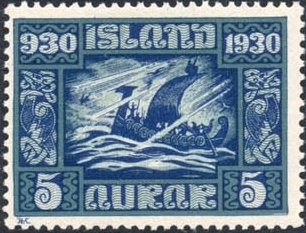Stamp: 1000 Years Allthing (First Session Of Parlament) (Iceland 1930)
1000 Years Allthing (First Session Of Parlament) (Iceland 1930)
01 January (Iceland ) within release First Session Of Parlament goes into circulation Stamp 1000 Years Allthing (First Session Of Parlament) face value 5 Icelandic eyrir
| Stamp 1000 Years Allthing (First Session Of Parlament) in catalogues | |
|---|---|
| Michel: | Mi:IS 126 |
Stamp is square format.
Also in the issue First Session Of Parlament:
- Stamp - 1000 Years Allthing (First Session Of Parlament) face value 3;
- Stamp - 1000 Years Allthing (First Session Of Parlament) face value 5;
- Stamp - 1000 Years Allthing (First Session Of Parlament) face value 7;
- Stamp - 1000 Years Allthing (First Session Of Parlament) face value 10;
- Stamp - 1000 Years Allthing (First Session Of Parlament) face value 15;
- Stamp - 1000 Years Allthing (First Session Of Parlament) face value 20;
- Stamp - 1000 Years Allthing (First Session Of Parlament) face value 25;
- Stamp - 1000 Years Allthing (First Session Of Parlament) face value 30;
- Stamp - 1000 Years Allthing (First Session Of Parlament) face value 35;
- Stamp - 1000 Years Allthing (First Session Of Parlament) face value 40;
- Stamp - 1000 Years Allthing (First Session Of Parlament) face value 50;
- Stamp - 1000 Years Allthing (First Session Of Parlament) face value 1;
- Stamp - 1000 Years Allthing (First Session Of Parlament) face value 2;
- Stamp - 1000 Years Allthing (First Session Of Parlament) face value 5;
- Stamp - 1000 Years Allthing (First Session Of Parlament) face value 10;
- Stamp - Gyrfalcon (Falco rusticolus) face value 10;
Stamp 1000 Years Allthing (First Session Of Parlament) it reflects the thematic directions:
A storm is any disturbed state of the natural environment or the atmosphere of an astronomical body.[citation needed] It may be marked by significant disruptions to normal conditions such as strong wind, tornadoes, hail, thunder and lightning (a thunderstorm), heavy precipitation (snowstorm, rainstorm), heavy freezing rain (ice storm), strong winds (tropical cyclone, windstorm), wind transporting some substance through the atmosphere such as in a dust storm, among other forms of severe weather.
The Viking Age (about 800–1050 CE) was the period during the Middle Ages when Norsemen known as Vikings undertook large-scale raiding, colonising, conquest, and trading throughout Europe and reached North America. The Viking Age applies not only to their homeland of Scandinavia but also to any place significantly settled by Scandinavians during the period. Although few of the Scandinavians of the Viking Age were Vikings in the sense of being engaged in piracy, they are often referred to as Vikings as well as Norsemen.
A modern sailing ship or sailship is any large wind-powered vessel. Traditionally a sailing ship (or simply ship) is a sailing vessel that carries three or more masts with square sails on each. Large sailing vessels that are not ship-rigged may be more precisely referred to by their sail rig, such as schooner, barque (also spelled "bark"), brig, barkentine, brigantine or sloop. There are many different types of sailing ships, but they all have certain basic things in common. Every sailing ship has a hull, rigging and at least one mast to hold up the sails that use the wind to power the ship. The crew who sail a ship are called sailors or hands. They take turns to take the watch, the active managers of the ship and her performance for a period. Watches are traditionally four hours long. Some sailing ships use traditional ship's bells to tell the time and regulate the watch system, with the bell being rung once for every half hour into the watch and rung eight times at watch end (a four-hour watch). Ocean journeys by sailing ship can take many months, and a common hazard is becoming becalmed because of lack of wind, or being blown off course by severe storms or winds that do not allow progress in the desired direction. A severe storm could lead to shipwreck, and the loss of all hands. Sailing ships are limited in their maximum size compared to ships with heat engines, so economies of scale are also limited. The heaviest sailing ships (limited to those vessels for which sails were the primary means of propulsion) never exceeded 14,000 tons displacement. Sailing ships are therefore also very limited in the supply capacity of their holds, so they have to plan long voyages carefully to include many stops to take on provisions and, in the days before watermakers, fresh water.


